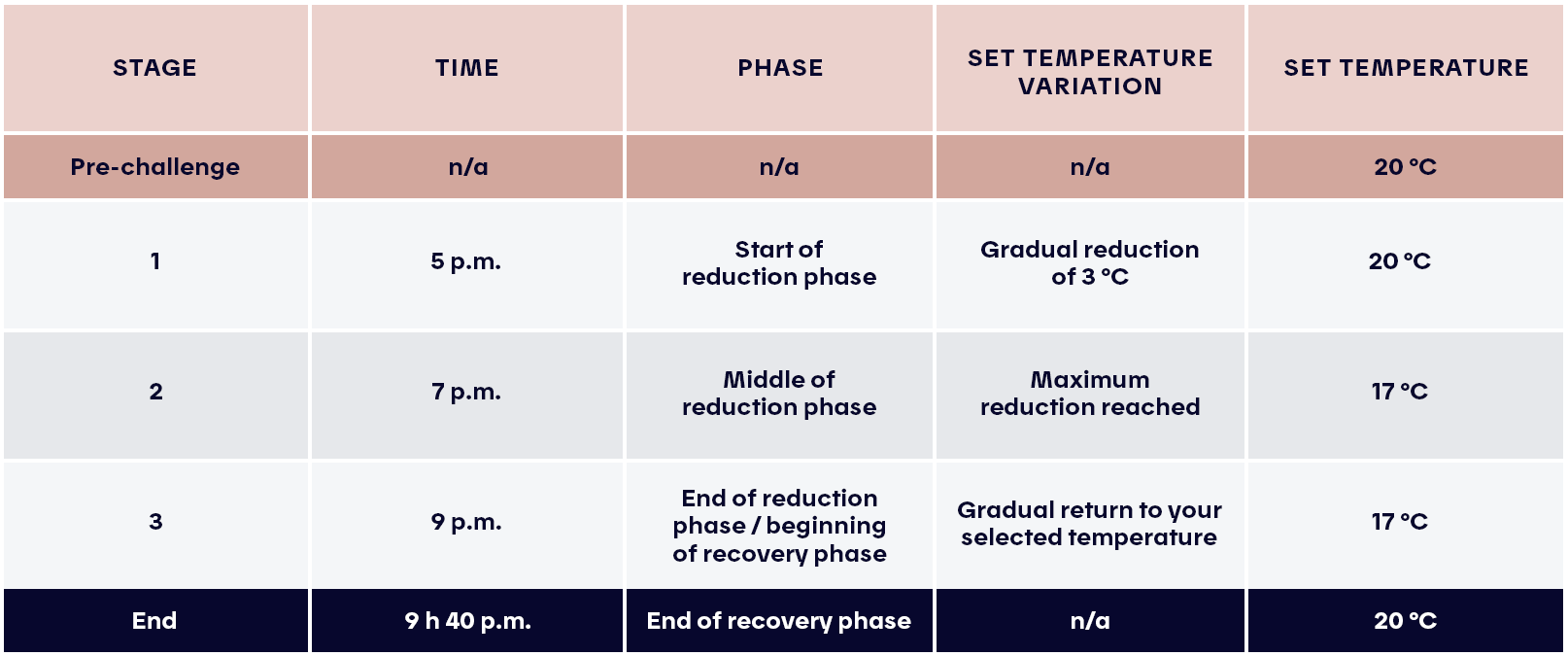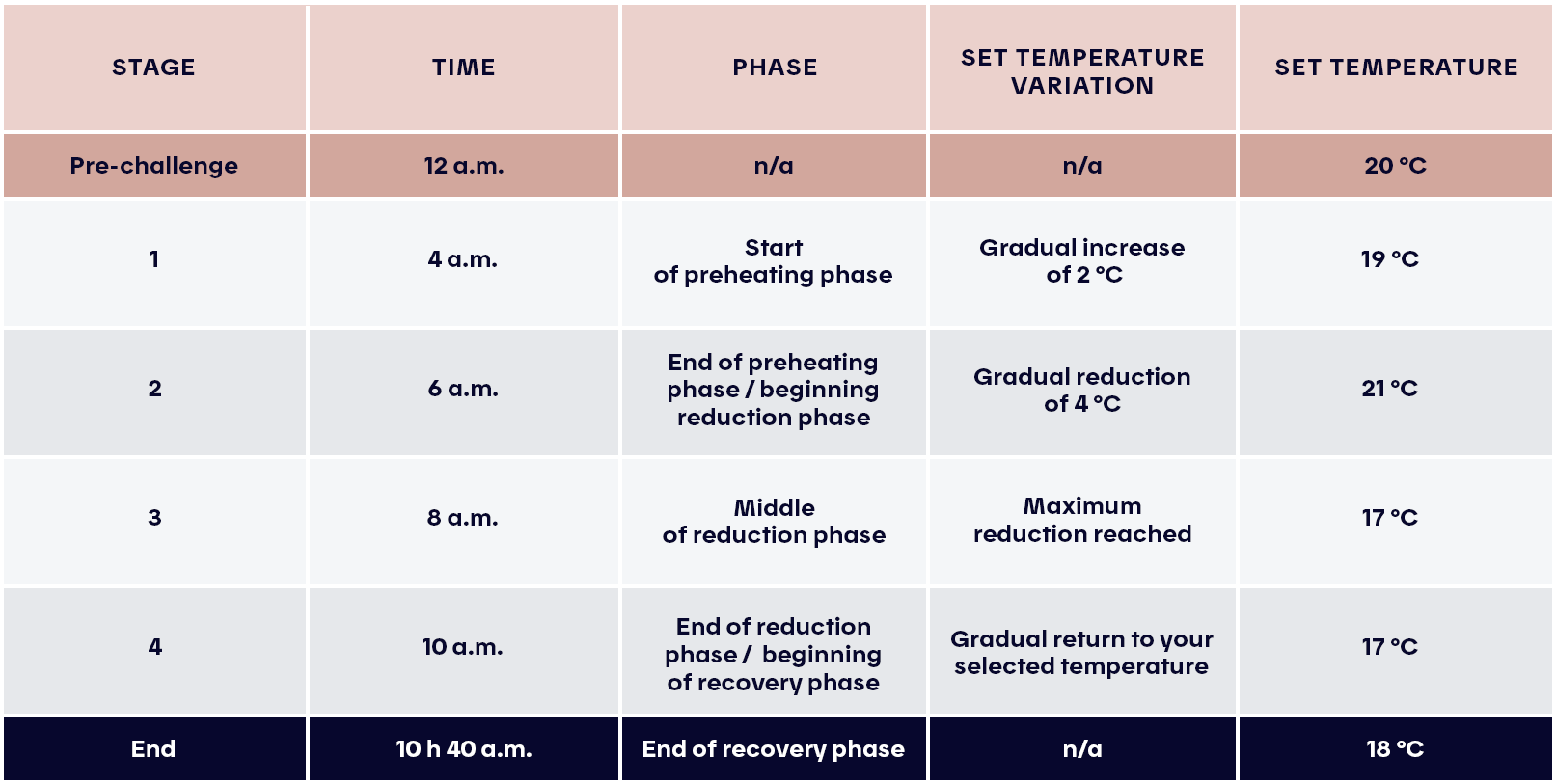Challenges
How could the programmed scenes affect the behaviour of my thermostats and the temperature during a challenge?
First, let’s review how a challenge works.
A challenge has three separate phases:
- An optional preheating phase from 4 a.m. to 6 a.m. for a morning challenge and 3 p.m. to 5 p.m. for an evening challenge
- A reduction phase from 6 a.m. to 10 a.m. for a morning challenge and 5 p.m. to 9 p.m. for an evening challenge
- A recovery phase from 10 a.m. to 11 a.m. for a morning challenge and 9 p.m. to 10 p.m. for an evening challenge.
Temperature variations during these three phases:
1. The optional preheating phase will gradually increase the set temperature of your thermostat by:
- 1.5 °C in Moderate mode
- 2 °C in Intrepid mode
- 2 °C in Extreme mode
Note that this temperature increase is applied in relation to the comfort level calculated by Hilo. The comfort level is equivalent to the average temperature during the reduction phase, i.e. between 6 a.m. and 10 a.m. for a morning challenge or between 5 p.m. and 9 p.m. for an evening challenge.
2. Regardless of whether you participate in the preheating phase, the reduction phase will gradually lower the set temperature of your thermostat by:
- 3 °C in Moderate mode
- 4 °C in Intrepid mode
- 6 °C in Extreme mode
Note that this temperature reduction is applied in relation to the comfort level calculated by Hilo.
3. The recovery phase will gradually return your thermostat’s set temperature to normal.
Note: The gradual variation of the set temperature during each phase occurs in stages and is applicable to each of the thermostats individually. These stages are illustrated in the examples below.
Examples
The following examples of Hilo challenges, which illustrate participation in Moderate and Intrepid mode, with or without scheduled scenes running during a challenge, will help you better understand how challenges work and how scheduled scenes can impact them.
Example 1
- Evening challenge
- Moderate mode without preheating
- No scheduled scenes during the challenge
- 20 °C set temperature at the start of the challenge
How it works

Example 2
- Morning challenge
- Intrepid mode with preheating
- With scheduled scenes during the challenge
The scheduled scenes have the following parameters:
- 12 a.m. – 17 °C set temperature
- 6 a.m. – 20 °C set temperature
- 8:15 a.m. – 18 °C set temperature
NOTE: In this example, the comfort level is 19 °C.
How the comfort level is calculated (reduction between 6 a.m. and 10 a.m.):
6 a.m. to 8:15 a.m. = 135 minutes, and 8:15 a.m. to 10 a.m. = 105 minutes (for a total of 240 minutes)
[(20 °C x 135 min) + (18 °C x 105 min)]/240 min = 19 °C (19.125 to the nearest half degree)
During the recovery phase, the temperature gradually returns to your chosen set temperature, i.e. 18 °C.
How it works

Additional Information
The set temperature of any given thermostat at the end of a challenge will be one of the following:
- The set temperature from the start of the challenge, if you had no scheduled scenes during the challenge
- The set temperature from the last scheduled scene that ran during the challenge
- The set temperature you selected when you took control of this thermostat
NOTE : Programs created or modified up until the beginning of the reduction phase of a challenge, will be considered in the setpoint plan. A program created or modified after the beginning of the reduction phase will not be considered for the current challenge.
There are a few possible exceptions to the temperature variations during each phase.
1. What happens during the preheating phase
- A scheduled scene will run during this phase if its set temperature is higher than [your comfort level] + [the expected temperature variation based on the chosen mode of participation at that time].
2. What happens during the reduction phase
- A scheduled scene will apply during this phase if its set temperature is lower than [your comfort level] + [the expected temperature variation based on the chosen mode of participation at that time].
3. What happens during the recovery phase
- If the set temperature of your scheduled scene is lower than the last temperature applied by Hilo during the reduction phase, the recovery phase will take this into account and not increase the temperature.
- If the set temperature of your scheduled scene is higher than the last temperature applied by Hilo during the reduction phase, the recovery phase will take this into account and adjust the temperature to match your selected temperature.
